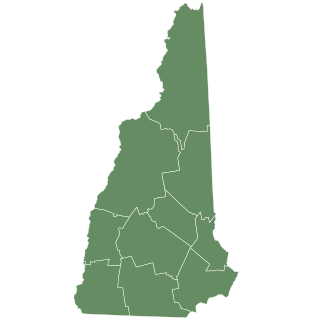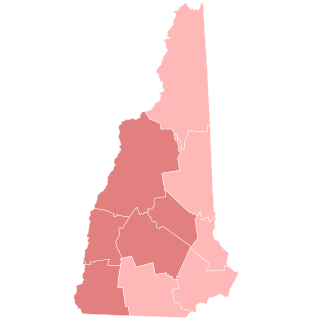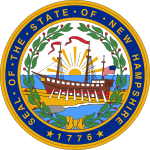
A Presidential election was held in the United States on November 4, 1952. Republican nominee Dwight D. Eisenhower defeated Democratic Illinois Governor Adlai Stevenson II in a landslide victory, becoming the first Republican president in 20 years. This was the first election since 1928 without an incumbent president on the ballot.

Presidential elections were held in the United States on November 6, 1956. Incumbent Republican President Dwight D. Eisenhower and his running mate, incumbent Vice President Richard Nixon, were reelected, defeating for a second time Democrat Adlai Stevenson II, former Illinois governor. This election was the sixth and most recent rematch in American presidential history. It was the second time in which the winner was the same both times, the first being William McKinley's victories over William Jennings Bryan in 1896 and 1900. This was the last election before term limits established by the Twenty-second Amendment to the United States Constitution, which first applied to Eisenhower, became effective.

Each of the 50 U.S. states, the District of Columbia, and five territories of the United States holds either primary elections or caucuses to help nominate individual candidates for president of the United States. This process is designed to choose the candidates that will represent their political parties in the general election.

Carey Estes Kefauver was an American politician from Tennessee. A member of the Democratic Party, he served in the U.S. House of Representatives from 1939 to 1949 and in the U.S. Senate from 1949 until his death in 1963.

The New Hampshire presidential primary is the first in a series of nationwide party primary elections and the second party contest, the first being the Iowa caucuses, held in the United States every four years as part of the process of choosing the delegates to the Democratic and Republican national conventions which choose the party nominees for the presidential elections to be held in November. Although only a few delegates are chosen in the New Hampshire primary, its real importance comes from the massive media coverage it receives, along with the first caucus in Iowa.

The 1956 Democratic National Convention nominated former Governor Adlai Stevenson of Illinois for president and Senator Estes Kefauver of Tennessee for vice president. It was held in the International Amphitheatre on the South Side of Chicago from August 13 to August 17, 1956. Unsuccessful candidates for the presidential nomination included Governor W. Averell Harriman of New York, Senator Lyndon B. Johnson of Texas, and Senator Stuart Symington of Missouri.

The 1952 Democratic National Convention was held at the International Amphitheatre in Chicago, Illinois from July 21 to July 26, 1952, which was the same arena the Republicans had gathered in a few weeks earlier for their national convention from July 7 to July 11, 1952. Four major candidates sought the presidential nomination: U.S. Senator Estes Kefauver of Tennessee, Governor Adlai Stevenson II of Illinois, Senator Richard Russell of Georgia and Averell Harriman of New York.

The Draft Eisenhower movement was a widespread political movement that eventually persuaded Dwight D. Eisenhower, former Chief of Staff of the United States Army, to contest the presidency of the United States.

From March 11 to June 3, 1952, voters and members of the Democratic Party elected delegates to the 1952 Democratic National Convention, partly for the purpose of choosing a nominee for president in the 1952 United States presidential election. Incumbent President Harry S. Truman withdrew his candidacy for re-election after losing the New Hampshire primary to Senator Estes Kefauver of Tennessee. Kefauver proceeded to win a majority of the popular vote, but failed to secure a majority of delegates, most of whom were selected through other means.

From March 11 to June 5, 1956, voters of the Democratic Party chose its nominee for president in the 1956 United States presidential election. Former Illinois Governor Adlai Stevenson was selected as the nominee through a series of primary elections and caucuses culminating in the 1956 Democratic National Convention held from August 13 to August 17, 1956, in Chicago, Illinois. This was the party's second consecutive nomination of Stevenson.

Electoral history of Harry S. Truman, who served as the 33rd president of the United States (1945–1953), the 34th vice president (1945), and as a United States senator from Missouri (1935–1945)

This is the electoral history of Adlai Stevenson II, who served as Governor of Illinois (1949–1953) and 5th United States Ambassador to the United Nations (1961–1965), and was twice the Democratic Party's nominee for President of the United States, losing both the 1952 and 1956 presidential general elections to Republican Dwight D. Eisenhower.

The 1952 United States presidential election in Illinois took place on November 4, 1952, as part of the 1952 United States presidential election. State voters chose 27 representatives, or electors, to the Electoral College, who voted for president and vice president.

The 1968 New Hampshire Democratic presidential primary was held on March 12, 1968, in New Hampshire as one of the Democratic Party's statewide nomination contests ahead of the 1968 United States presidential election.

The 1964 New Hampshire Democratic presidential primary was held on March 10, 1964, in New Hampshire as one of the Democratic Party's statewide nomination contests ahead of the 1964 United States presidential election.

The 1960 New Hampshire Democratic presidential primary was held on March 8, 1960, in New Hampshire as one of the Democratic Party's statewide nomination contests ahead of the 1960 United States presidential election.

The 1956 New Hampshire Democratic presidential primary was held on March 13, 1956, in New Hampshire as one of the Democratic Party's statewide nomination contests ahead of the 1956 United States presidential election.

The 1956 New Hampshire Republican presidential primary was held on March 13, 1956, in New Hampshire as one of the Republican Party's statewide nomination contests ahead of the 1956 United States presidential election. Incumbent President Dwight Eisenhower ran unopposed, and won the Granite State by the largest margin in history since the advent of the New Hampshire primary's direct vote for president in 1952.

The 1952 New Hampshire Republican presidential primary was held on March 11, 1952, in New Hampshire as one of the Republican Party's statewide nomination contests ahead of the 1952 United States presidential election. General Dwight D. Eisenhower defeated Senator Robert Taft of Ohio by 12 percentage points on his way to eventual nomination by the Republican Party for President and victory in the 1952 election against Democrat Adlai Stevenson. This was the first time that voters participating in the New Hampshire primary could vote directly for candidates, rather than for delegates to the Republican National Convention.




















